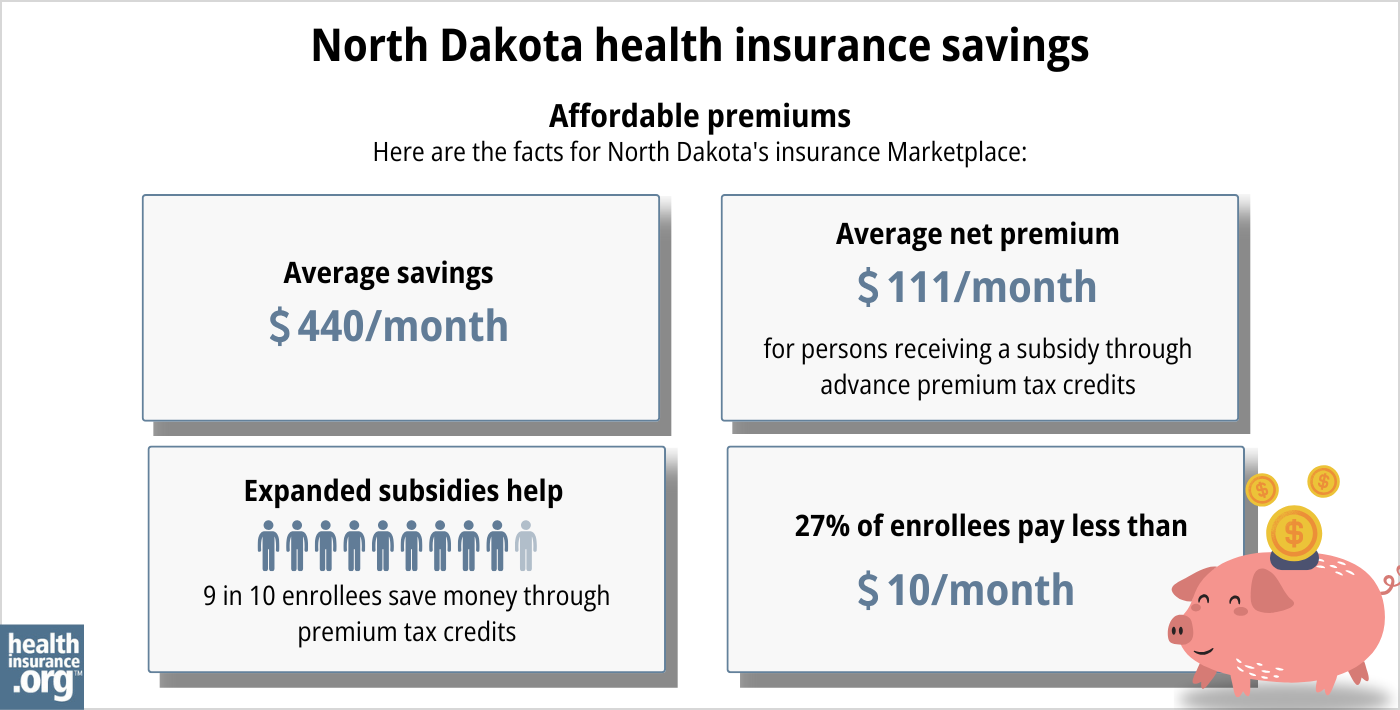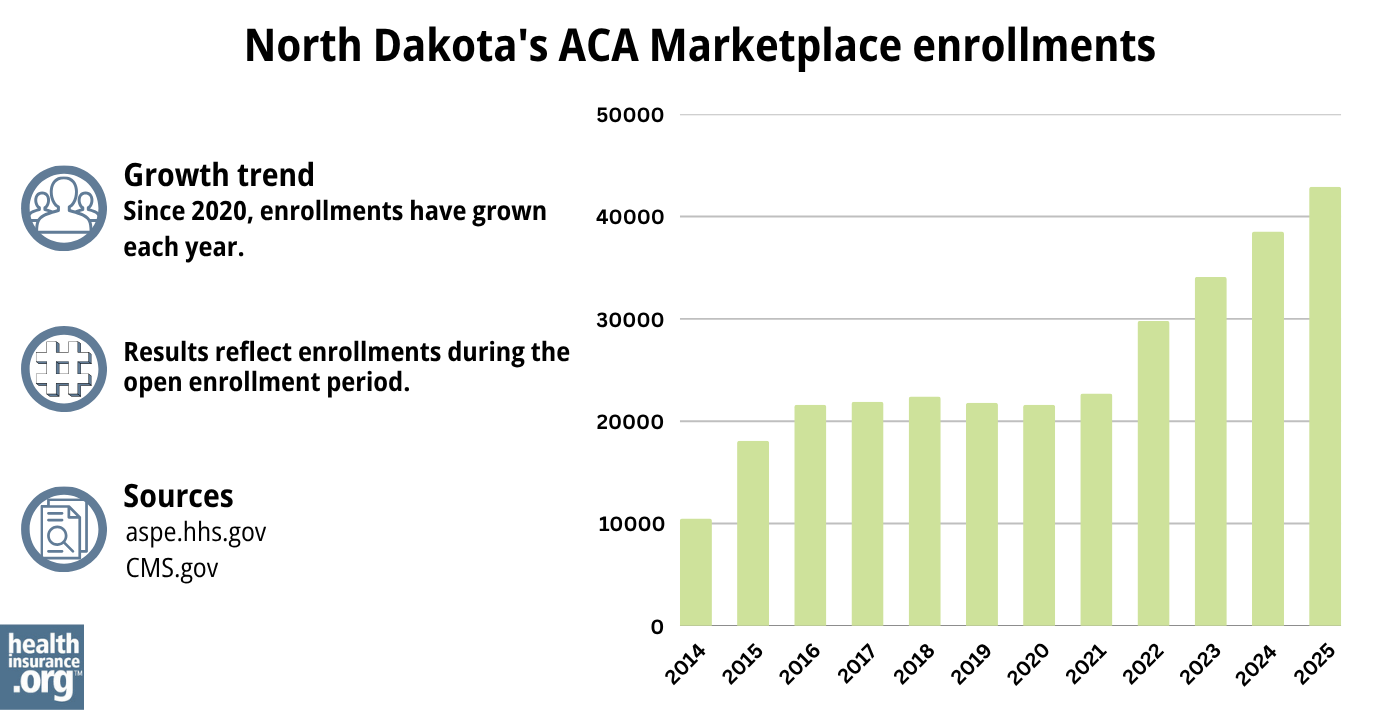Home > Health insurance Marketplace > North Dakota
North Dakota Marketplace health insurance in 2025

Compare ACA plans and check subsidy savings from a third-party insurance agency.

North Dakota health insurance Marketplace guide
We’ve compiled this guide, including the FAQs below, to help you choose the right health insurance plan for you and your family. An ACA Marketplace (exchange) plan is a good option for people in North Dakota who don’t have access to Medicare, Medicaid, or an employer-sponsored plan and thus need to buy their own individual or family health coverage.
In North Dakota, you can sign up for ACA Marketplace coverage through HealthCare.gov, as North Dakota uses the federally-facilitated Marketplace. Three private insurance companies offer coverage through the North Dakota health insurance Marketplace, and residents in most counties can choose from among all three insurers’ plans.3 All three insurers will continue to offer Marketplace coverage in 2025.4
Depending on your income and other circumstances, you may also get help to lower your monthly insurance premium (the amount you pay to enroll in the coverage) and possibly your out-of-pocket expenses.
North Dakota has updated its essential health benefits benchmark plan for 2025, so individual and small group plans in the state will include additional benefits in 2025, including coverage for weight loss medications and limited out-of-pocket costs for insulin.5
Frequently asked questions about health insurance in North Dakota
Who can buy Marketplace health insurance?
To enroll in private health coverage through the Marketplace in North Dakota, you must:6
- Be a North Dakota resident
- Be either a United States citizen or national, or be lawfully present
- Not be incarcerated
- Not have Medicare coverage7
Eligibility for financial assistance (premium subsidies and cost-sharing reductions) depends on your household income. In addition, to qualify for financial assistance with your North Dakota Marketplace plan you must:
- Not have access to affordable health coverage offered by an employer. If your employer offers coverage but you feel it’s too expensive, you can use our Employer Health Plan Affordability Calculator to see if you might qualify for premium subsidies in the Marketplace.
- Not be eligible for Medicaid or CHIP.
- Not be eligible for premium-free Medicare Part A.8
- If married, file a joint tax return.9
- Not be able to be claimed by someone else as a tax dependent.9
When can I enroll in an ACA-compliant plan in North Dakota?
In North Dakota, you can sign up for an ACA-compliant individual or family health plan from November 1 to January 15 during open enrollment.10
If you need your coverage to start on January 1, you must apply by December 15. If you apply between December 16 and January 15, your coverage will begin on February 1.6
Outside of the open enrollment window, you may be eligible to enroll if you meet the following requirements:
- You experience a qualifying life event, such as giving birth or losing other health coverage. If you already had prior coverage, you can enroll in a new plan due to certain qualifying life events such as marriage or moving to an area where different health plans are available.
- You belong to a federally recognized American Indian tribe.
- You can enroll anytime if you’re eligible for subsidies in the Marketplace and your income doesn’t exceed 150% of the poverty level.
In addition, enrollment in Medicaid/CHIP is available year-round, so if you’re eligible for North Dakota Medicaid or CHIP, you can enroll anytime.
How do I enroll in a Marketplace plan in North Dakota?
To enroll in an ACA Marketplace plan in North Dakota, you can:
- Visit HealthCare.gov, which is North Dakota’s health insurance Marketplace. HealthCare.gov provides an online platform to shop, compare, and buy health plans.
- Purchase individual and family health coverage with the help of an insurance agent or broker, a Navigator, or a certified application counselor.
- Enroll via an approved enhanced direct enrollment (EDE) entity.11 (EDEs can also facilitate enrollment in off-exchange plans and sometimes non-ACA-compliant plans. So be sure to specify that you’re looking for a Marketplace/exchange plan, as that’s the only way you can take advantage of the available financial assistance.)
You can also call HealthCare.gov’s contact center by dialing 1-800-318-2596 (TTY: 1-855-889-4325). The call center is available 24 hours a day, seven days a week, but it’s closed on holidays.
How can I find affordable health insurance in North Dakota?
You may find affordable health insurance options in North Dakota by signing up through HealthCare.gov – especially if you’re eligible for subsidies.
Under the Affordable Care Act, there are income-based subsidies – a type of financial assistance – called Advance Premium Tax Credits (APTC). APTCs can help lower your premium payments each month.12
As of 2024, more than nine out of ten North Dakota Marketplace enrollees were receiving premium subsidies that saved them an average of $434/month. After subsidies were applied, the average enrollee’s monthly cost was about $128/month (including those who paid full price).13
(Note that the numbers above are based on effectuated enrollment in early 2024; the chart below has different metrics, and has data based on total applications submitted during the open enrollment period for 2024 coverage.)
For people who do not qualify for premium subsidies, North Dakota’s reinsurance program, which took effect in 2020, serves to keep full-price premiums lower than they would otherwise be.14
If your household income is no more than 250% of the federal poverty level, you may also qualify for cost-sharing reductions (CSR). These reductions can lower your deductibles and out-of-pocket expenses as long as you select a Silver-level plan. As of 2024, more than a quarter of North Dakota Marketplace enrollees were receiving CSR benefits.15
Combining APTCs and CSRs might make an ACA plan the most budget-friendly health insurance choice for you.

Source: CMS.gov16
Depending on your income and circumstances, you may find that you’re eligible for free or low cost health coverage through Medicaid or CHIP. Check to see if you meet the criteria for Medicaid in North Dakota.
If it looks like you’re eligible for Medicaid based on the income you report to the Marketplace, they will refer you to North Dakota Medicaid Services.
How many insurers offer Marketplace coverage in North Dakota?
Are Marketplace health insurance premiums increasing in North Dakota?
The following average rate increases have been approved for North Dakota’s Marketplace insurers for 2025, applicable to full-price (pre-subsidy) premiums:4
North Dakota’s ACA Marketplace Plan 2025 APPROVED Rate Increases by Insurance Company |
|
|---|---|
| Issuer | Percent Increase |
| Blue Cross Blue Shield of North Dakota | 15.94% |
| Medica Health Plans | 4.6% |
| Sanford Health Plan | 16.5% |
Source: North Dakota Insurance Department4
(Sanford has 20,713 members, Blue Cross Blue Shield of ND has roughly 31,000. Medica’s redacted filing doesn’t indicate how many enrollees they have,17 but it appears to be fairly low given the overall size of the individual market in North Dakota.18)
More than nine out of ten North Dakota Marketplace enrollees receive subsidies,15 and their net premium changes depend on how subsidies change as well as how the rates for their plan change and whether they pick a different plan during open enrollment. Subsidies grow if the cost of the benchmark (second-lowest-cost Silver) plan increases, which is likely to be the case in North Dakota in 2025.
The American Rescue Plan, enacted in March 2021, increased the size of premium subsidies and made the subsidies more widely available.19 Fortunately for exchange enrollees, those subsidy enhancements have been extended through 2025 by the Inflation Reduction Act.
For perspective, here’s an overview of how full-price premiums have changed in North Dakota’s individual/family market over the years:
- 2015: Average increase of 7%20
- 2016: Average increase of 12%21
- 2017: Average increase of 1.3%22
- 2018: Average increase of 23%23 (ND did not let insurers add the cost of CSR to 2018 premiums)
- 2019: Average increase of 3.2%24
- 2020: Average decrease of 5.8%25 (reinsurance took effect)14
- 2021: Average increase of 3%26
- 2022: Average increase of 1.25%27
- 2023: Average increase of 4.4%28
- 2024: Average increase of 3%29
How many people are insured through North Dakota’s Marketplace?
In the open enrollment period for 2024 coverage, 38,535 people signed up for private plans through the North Dakota Marketplace.30
This was the fourth year with a new record-high enrollment (see chart below for year-by-year enrollment totals). The enrollment growth was due in large part to the subsidy enhancements created by the American Rescue Plan. Premium subsidies are larger and more widely available than they used to be, and these subsidy enhancements have been extended through 2025 by the Inflation Reduction Act.
The enrollment spike in 2024 was also due in part to the “unwinding” of the pandemic-era Medicaid continuous coverage rule. Medicaid disenrollments resumed in 2023 after a three-year pause. By April 2024, more than 6,000 North Dakota residents had transitioned from Medicaid to a Marketplace plan during the unwinding process.31

Source: 2014,32 2015,33 2016,34 2017,35 2018,36 2019,37 2020,38 2021,39 2022,40 2023,19 2024,41 202542
As of early 2023, there were 32,970 people with effectuated coverage through the North Dakota Marketplace.43
Effectuated enrollment numbers are always a little lower than the number of people who sign up during open enrollment, because some enrollees never pay their first premium to effectuate their coverage, and others choose to cancel their coverage instead of keeping it for the full year.
What health insurance resources are available to North Dakota residents?
HealthCare.gov: The Marketplace in North Dakota, where residents can enroll in individual/family health coverage and receive income-based subsidies. You can reach HealthCare.gov at 800-318-2596.
North Dakota Department of Human Services: The North Dakota Department of Human Services administers Medicaid and CHIP, as well as other social services programs. You can reach them at 701-328-2310 (For TTY, use relay North Dakota at 711 or 1-800-366-6888).
North Dakota Insurance Department: Regulates the insurance industry in North Dakota, and provides assistance to consumers and businesses with insurance-related questions and concerns.
North Dakota State Health Insurance Counseling Program: A local service for Medicare beneficiaries, which can provide information and assistance with questions related to Medicare eligibility, enrollment, and claims.
Louise Norris is an individual health insurance broker who has been writing about health insurance and health reform since 2006. She has written dozens of opinions and educational pieces about the Affordable Care Act for healthinsurance.org.

Looking for more information about other options in your state?
Need help navigating health insurance options in North Dakota?
Explore more resources for options in North Dakota including short-term health insurance, dental insurance, Medicaid and Medicare.
Speak to a sales agent at a licensed insurance agency.
Footnotes
- ”2025 OEP State-Level Public Use File (ZIP)” Centers for Medicare & Medicaid Services, Accessed May 13, 2025 ⤶ ⤶
- ”Rate Review Submissions” RateReview.HealthCare.gov. Accessed Jan. 7, 2025 ⤶
- Plan Year 2024 Qualified Health Plan Choice and Premiums in HealthCare.gov Marketplaces. Centers for Medicare and Medicaid Services. October 25, 2023. ⤶ ⤶
- ”Godfread announces 2025 ACA plan rates, citing increasing prices for healthcare services as lead factor” North Dakota Insurance Department, EIN Presswire. Oct. 22, 2024 ⤶ ⤶ ⤶ ⤶
- ”Feds approve new benefits for North Dakota ACA plans” North Dakota Insurance Department. Sept. 5, 2023 ⤶
- “A quick guide to the Health Insurance Marketplace®” HealthCare.gov, Accessed August, 2023 ⤶ ⤶
- Medicare and the Marketplace, Master FAQ. Centers for Medicare and Medicaid Services. Accessed November 2023. ⤶
- Medicare and the Marketplace, Master FAQ. Centers for Medicare and Medicaid Services. Accessed November 2023. ⤶
- Premium Tax Credit — The Basics. Internal Revenue Service. Accessed May 10, 2024 ⤶ ⤶
- “When can you get health insurance?” HealthCare.gov, 2023 ⤶
- “Entities Approved to Use Enhanced Direct Enrollment” CMS.gov, April 28, 2023 ⤶
- “APTC and CSR Basics” CMS.gov, June 2024 ⤶
- ”Effectuated Enrollment: Early 2024 Snapshot and Full Year 2023 Average” CMS.gov, July 2, 2024 ⤶
- North Dakota: State Innovation Waiver under section 1332 of the PPACA. Centers for Medicare and Medicaid Services. July 2019. ⤶ ⤶
- ”Effectuated Enrollment: Early 2024 Snapshot and Full Year 2023 Average” CMS.gov, July 2, 2024 ⤶ ⤶
- “2025 Marketplace Open Enrollment Period Public Use Files” CMS.gov, May 2025 ⤶
- ”North Dakota Rate Review Submissions” RateReview.HealthCare.gov. And North Dakota SERFF. Accessed Aug. 14, 2024 ⤶
- ”North Dakota: Preliminary avg. unsubsidized 2025 #ACA rate changes:+16.7%” ACA Signups. Sep. 9. 2024 ⤶
- “Health Insurance Marketplaces 2023 Open Enrollment Report” CMS.gov, 2023 ⤶ ⤶
- Analysis Finds No Nationwide Increase in Health Insurance Marketplace Premiums. The Commonwealth Fund. December 2014. ⤶
- Private Health Insurance Market Report, 2014-2018. North Dakota Insurance Department. Accessed December 2023. ⤶
- Avg. UNSUBSIDIZED Indy Mkt Rate Hikes: 25% (49 States + DC). ACA Signups. October 2016. ⤶
- 2018 Rate Hikes: North Dakota. ACA Signups. August 2017. ⤶
- North Dakota: APPROVED 2019 #ACA Rates: 3.2% Increase…But Likely Would’ve DROPPED Nearly 20% W/Out #ACASabotage. ACA Signups. September 2018. ⤶
- 2020 Rate Changes. ACA Signups. October 2019. ⤶
- 2021 Rate Changes. ACA Signups. October 2020. ⤶
- 2022 Rate Changes. ACA Signups. October 2021. ⤶
- North Dakota: Approved Avg. 2023 #ACA Rate Changes: +4.4%. ACA Signups. August 2022. ⤶
- North Dakota: *Final* Avg. Unsubsidized 2024 #ACA Rate Changes: +3.0% (Corrected). ACA Signups. October 2023. ⤶
- ”Health Insurance Marketplaces 2024 Open Enrollment Period Report” CMS.gov. March 22, 2024 ⤶
- ”HealthCare.gov Marketplace Medicaid Unwinding Report” Centers for Medicare & Medicaid Services. Data through April 2024; Accessed Aug. 14, 2024. ⤶
- “ASPE Issue Brief (2014)” ASPE, 2015 ⤶
- “Health Insurance Marketplaces 2015 Open Enrollment Period: March Enrollment Report”, HHS.gov, 2015 ⤶
- “HEALTH INSURANCE MARKETPLACES 2016 OPEN ENROLLMENT PERIOD: FINAL ENROLLMENT REPORT” HHS.gov, 2016 ⤶
- “2017 Marketplace Open Enrollment Period Public Use Files” CMS.gov, 2017 ⤶
- “2018 Marketplace Open Enrollment Period Public Use Files” CMS.gov, 2018 ⤶
- “2019 Marketplace Open Enrollment Period Public Use Files” CMS.gov, 2019 ⤶
- “2020 Marketplace Open Enrollment Period Public Use Files” CMS.gov, 2020 ⤶
- “2021 Marketplace Open Enrollment Period Public Use Files” CMS.gov, 2021 ⤶
- “2022 Marketplace Open Enrollment Period Public Use Files” CMS.gov, 2022 ⤶
- ”HEALTH INSURANCE MARKETPLACES 2024 OPEN ENROLLMENT REPORT” CMS.gov, 2024 ⤶
- “2025 Marketplace Open Enrollment Period Public Use Files” CMS.gov, May 2025 ⤶
- “Effectuated Enrollment: Early 2023 Snapshot and Full Year 2022 Average” CMS.gov, March 15, 2023 ⤶

